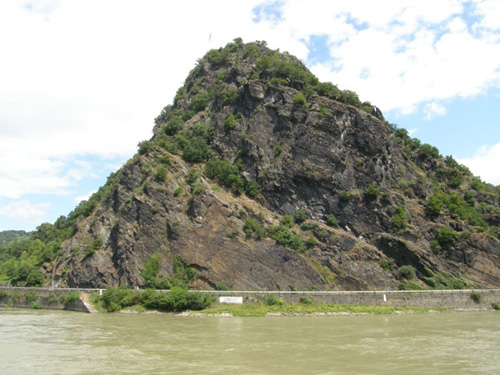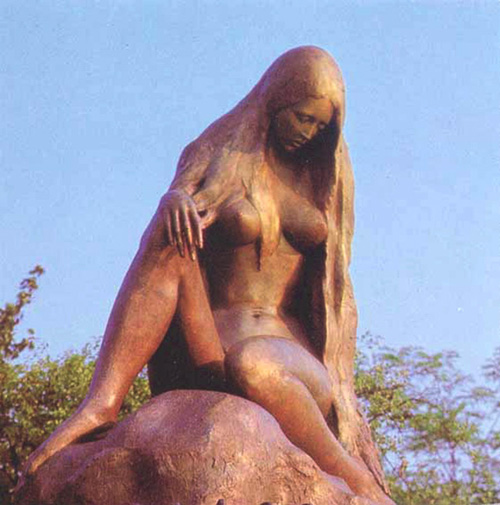
Das Obere Mittelrheintal - seit dem Jahre 2002 UNESCO Weltkulturerbe - lässt kaum glauben, dass hier vor 400 Millionen Jahren ein Ozean die Region bedeckte. Zeit, Wasserkraft und die Kräfte der Erde schufen über Jahrmillionen dieses unverwechselbare Tal, in dem auch der Loreleyfelsen entstand.

Lorelyfelsen - Loreley Rock
Vor 325 Millionen Jahren, an der Wende zum Erdzeitalter des Karbons, kam es zu einer Erdplatten-Kollision, die den Ozean vollständig verschwinden ließ. Es formte sich ein Gebirge, das sich je nach Stärke von Druck und Hitze aus unterschiedlichen Gesteinen zusammensetzte. Hauptsächlich Tonschiefer, Sandsteine - so genannte Grauwacken und Quarzite bestimmen bis heute die Geologie. Die Gesteine wurden zusammengeschoben und aufgefaltet. Die nachfolgenden Zeitalter ließen das Gebirge verwittern. Es entstand eine einzigartige Landschaft.
Der Loreleyfelsen ragt bei St. Goarshausen aus der Erde. Da der Rhein an dieser Stelle sehr eng und mit 27 Metern auch sehr tief ist, verunglückten hier früher viele Schiffe an Felsriffen, die unter der Wasseroberfläche nicht sichtbar waren. In der Epoche der Romantik entstand im 19. Jahrhundert der Mythos der Loreley. Das Volk sprach von einem schönen Mädchen oder auch von einer Meerjungfrau mit langen blonden Haaren, die auf dem Loreley-Felsen saß und ihr Haar kämmte. Der Gesang und das Aussehen dieser Jungfrau waren so schön, dass die Schiffer von ihrem Weg abkamen und den Tod fanden - so erzählt die Sage.

Loreleystatue - Statue of the Loreley
Der Rhein erscheint zum ersten Mal als kleiner Rinnsal vor rund 25 Millionen Jahren. Der heutige Rheinlauf entwickelte sich erst in den vergangenen 2,5 Millionen Jahren. Eiszeiten bescherten ein rauheres Klima, und tektonische Bewegungen führten zu Zeiten abwechselnder Ruhe und Hebungsphasen. Viel Wasser und Geröll flossen von den Gletschern des Alpenraums und führten zu den bis heute so beeindruckenden Einschnitten des Rheines. Die steilen Talhänge (Canyon) liegen etwa zwischen 70 und 200 Meter über dem Meeresspiegel und entstanden während der Eiszeiten der letzten 700.000 Jahre.
Zum Cache:
Die Terrainwertung bezieht sich auf ein Besteigen des Loreleyfelsens vom Rheinufer aus. Der Aufstieg dauert etwa 30 Minuten und bietet tolle Ausblicke. Das Besucherzentrum lässt sich aber auch mit einem Fahrzeug erreichen, die Terrainwertung halbiert sich dann.
Am Besucherzentrum bei N 50.08.515 E 007.43.944 (grüne Infotafel) findet Ihr Hilfe zur Beantwortung der Fragen.
Du kannst den Cache direkt loggen, nachdem Du mir eine Mail mit den korrekten Antworten gesendet hast. Es ist nicht notwendig, eine Logfreigabe abzuwarten.
1. Wie hoch ist der Lorelyfelsen?
2. Aus welcher Gesteinsart besteht er?
3. Wie hoch ist die bronzene, mythische Statue der Loreley auf der Landzunge vor St. Goarshausen?
4. Welcher deutsche Dichter schrieb das berühmte Gedicht "Loreley"?
5. Mache ein Foto von Dir und Deinem GPSr bei N 50.08.485 E 007.43.803 und lade es mit Deinem Logeintrag hoch. Von hier aus hat man einen einzigartigen Blick über das Rheintal.
Da es im Netz zu den Fragen 1, 3 und 4 teilweise abweichende Antworten gibt, werten wir nur Antworten richtig, die mit den Angaben auf der Infotafel übereinstimmen.

The Upper Middle Rhine Valley - since 2002 declared a UNESCO World Heritage - barely let you believe that 400 million years ago an ocean covered this region. Time, force of water and the strengths of the Earth formed this distinctive valley over the millenias, in which also the Loreley Rock is located.
325 mio years ago, at the turn toward the Carboniferous a collision of the tectonical plates took place and made the ocean disappear completely. Mountains formed, varying by strength of pressure and heat of the different rocks. Mainly argillite, sandstones - so called quarzites - dominate the geology even today. The rocks were thrust together and unfolded. The following ages weathered the mountains . A unique landscape developed.
The Lorelei (also spelled Loreley) soars above the water line near St. Goarshausen. Since this is the narrowest part of the Rhine and with 27 m (appr. 30 yards) also very deep many ships collided with the rocky reefs that were not visible under the surface of the water. In the era of the Romanticism in the 19th century the myth of Loreley developed. People spoke of a beautiful girl or mermaid with long golden hair, who sat at the Loreley rock combing her hair. The singing an the appearance of this virgin was so wonderful that the skipper lost their way and found death - so the legend says.
The Rhine first appears as a small trickle aprox. 25 mio years ago. Today's Rhine developedn during the last 2,5 mio years. Ice ages brought a rougher climate and tectonical movements led to rotating of rest and elevation. A mass of water and debris came from the glaciers of the alps and formed these - even today- impressive gashes of the Rhine. The steep Canyons lay appro. 75 to 220 yards above sea level and developed during the ice ages of the last 700.000 years
The Cache:
The terrain evaluation applies to the climbing the stairs to the rock from the bank of the Rhine. The ascent takes appr.30 min and offers great views.
The tourist center can be reached by vehicle, the terrain evalution bisects.
At the tourist center at N 50.08.515 E 007.43.944 you'll find help answering the questions.
To log the cache as found, please send a mail with the answers to following questions:
1. How high soars the Loreley Rock?
2. Which type of rock is it?
3. What is the height of the bronzen, mythical statue of the Loreley on the hook at St. Goarshausen ?
4. What German Poet wrote the famous poet "Loreley"
5. Please take e picture of you and your GPSr at N 50.08.485 E 007.43.803. From here you have a wonderful view over the Rhine Valley.
Since there are partly deviant answers to question no. 1, 3 and 4 in the web, we will only accept those answers that are consistent with the info panel.
